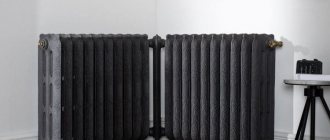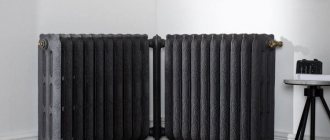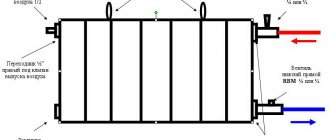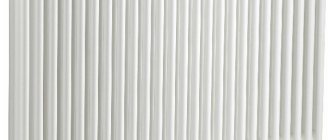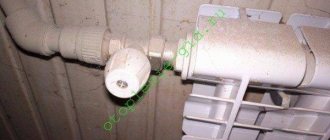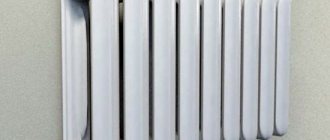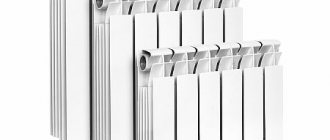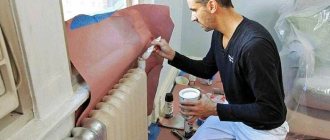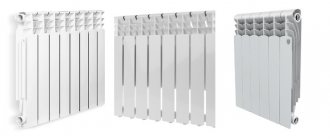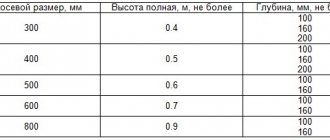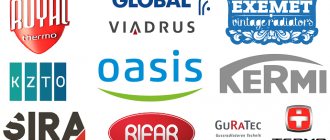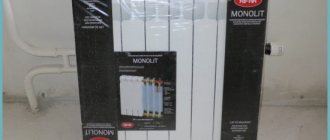Cast iron radiators are considered the most suitable for heating apartments and private houses.
Contrary to popular belief, such batteries are not a relic of the past. Thanks to the use of modern technologies, they perform not only a practical, but also a decorative function, because they are often decorated with forging elements.
Despite the fact that the popularity of cast iron batteries has decreased slightly, many users prefer these models.
They are very durable and wear-resistant, have increased resistance to rust, heat up quickly and cool down slowly.
To make it easier to choose a suitable heating device, we have compiled a rating of the best cast iron batteries according to the 2022 version and a short list of criteria that people pay attention to when choosing.
Rating of the TOP 15 best cast iron heating radiators of 2021
| Place | Name | Price |
| TOP 3 best cast iron heating radiators by price/quality for 2022 | ||
| 1 | Exemet Romantica | Find out the price |
| 2 | RETROstyle WINDSOR | Find out the price |
| 3 | RETROstyle CHAMONIX | Find out the price |
| TOP 3 best modern cast iron radiators | ||
| 1 | STI Nova | Find out the price |
| 2 | Conner Modern | Find out the price |
| 3 | Viadrus Style | Find out the price |
| TOP 3 best retro cast iron radiators | ||
| 1 | RETROstyle BARTON | Find out the price |
| 2 | Exemet Rococo | Find out the price |
| 3 | RETROstyle DERBY M | Find out the price |
| TOP 3 best floor-mounted cast iron radiators | ||
| 1 | GuRaTec Diana | Find out the price |
| 2 | RETROstyle TELFORD | Find out the price |
| 3 | Iron Lion Mangus | Find out the price |
| TOP 3 best inexpensive cast iron radiators | ||
| 1 | RETROstyle TOULON | Find out the price |
| 2 | Viadrus Kalor | Find out the price |
| 3 | Exemet Neo 3 | Find out the price |
The best models with floor installation
Note! Floor-mounted radiators are the best option for those with panoramic windows.
In such cases, installation of wall structures is not possible. Advantages of floor-standing devices :
- Compact dimensions. These are the smallest devices that can be found on the heating market.
- Exterior. Modern designs are made in a universal style and will not spoil even the most sophisticated interior.
- Wide range of colors. If wall-mounted radiators are produced predominantly in white, then floor-standing units can be made in different shades. There are models with a textured pattern like wood or granite.
- Easy installation. The batteries are installed on legs - pipes coming from the floor or walls.
- Possibility of heating large rooms.
Disadvantages of floor radiators:
- pipe routing must be done in the floor, otherwise installation difficulties will arise;
- heating is carried out only by convection method;
- high price.
Let's consider the best models of cast iron radiators with floor installation.
Iron Lion Azalia 950
An original device made in retro style.
When choosing this model, you should take into account the design of the room in which it is to be installed.
After all, retro will not suit such styles as hi-tech, minimalism, modern, etc.
As for functionality, this is a truly high-quality heating device that produces heat quickly.
Specifications:
- connection - lateral;
- type - sectional;
- maximum operating pressure - 10 bar;
- height - 95 cm;
- width of one section - 7 cm;
- thickness - 14 cm;
- the weight of one section is 11 kg.
Advantages
- unusual design;
- ease of installation;
- rich equipment;
- quickly heats the room;
- reliability.
Flaws
- heavy weight;
- high price;
- not a universal exterior.
RETROstyle BRISTOL 800
An unusual model with an embossed pattern over the entire surface.
The radiator is made in a dark color, which allows you to visually save space in the room.
The original design of the structure will simply become the star of the room, since not every battery can boast of such an exterior.
Specifications:
- connection - lateral;
- type - sectional;
- maximum operating pressure - 10 bar;
- height - 96 cm;
- width of one section - 8 cm;
- thickness - 25 cm;
- the weight of one section is 18.6 kg.
Advantages
- unusual exterior;
- high heat transfer;
- rich equipment;
- high build quality;
- Scratches, chips, and mechanical damage are not visible on the surface.
Flaws
- high price;
- bulky design that needs to be played up in the interior;
- heavy weight.
RETROstyle DERBY M 320
A model with a discreet design, made in black.
The radiator is a continuation of the Soviet and post-Soviet classics.
There were batteries of almost the same shape in every apartment, only white.
The device quickly heats large rooms and has a long service life.
Specifications:
- connection - lateral;
- type - sectional;
- maximum operating pressure - 10 bar;
- height - 48 cm;
- width of one section - 6.3 cm;
- thickness - 17.4 cm;
- the weight of one section is 5.5 kg.
Advantages
- acceptable price;
- quickly warms up the room;
- relatively light design;
- uniform coverage;
- long service life.
Flaws
- Even small scratches are visible on the surface;
- not always high-quality assembly;
- The design will not be to everyone's taste.
How to choose cast iron radiators in terms of price/quality ratio?
The main criterion for choosing a cast iron battery is its thermal power. For a room with a standard ceiling height (250-270 cm), a 120 W battery will be sufficient.
The following characteristics are also taken into account:
- Radiator color . The traditional color of radiators is white, but on the modern market there are models in dark shades. This option is better, because black or brown batteries give off heat better.
- Location . Most models of cast iron radiators are designed for wall mounting, but there are radiators for floor installation. In the first case, fasteners for installation are provided with the battery, and in the second case, the radiator is equipped with special stable legs.
- Maximum pressure . Outdated radiators could withstand pressures of up to 8-10 atmospheres. Modern models are able to withstand changes from 12 to 18 atmospheres.
- Coolant volume . In the past, it was this indicator that played a key role when choosing a radiator, so in older models the coolant volume was one and a half liters. In modern radiators this figure has dropped to 0.8 liters.
It is not recommended to repaint batteries frequently, since each layer of paint reduces heat transfer.
The best wall-mounted models
Wall installation of a cast iron radiator is the most common and easiest way. Among the advantages of such structures it is worth noting:
- high heat transfer rate due to the large area of contact with air;
- variety of sizes, shapes, designs - you can choose according to the interior of the room;
- high heating speed;
- ease of installation;
- saving space under the window.
Keep in mind! As for the disadvantages, these include:
- uneven heating of the room - warm air accumulates in the ceiling area, the floor still remains cold;
- it is impossible to unnoticedly route pipes to the radiator;
- heavy weight, not suitable for plasterboard walls.
TOP 5 best models with wall installation in terms of price and quality ratio.
Konner Modern 500
The perfect combination of style and high quality heating .
The outer surface is perfectly processed - has no unnecessary bulges. Therefore, it fits easily under the window sill to the wall.
It is compact and can be hidden well under a curtain, although it can become a harmonious element of a room interior.
In appearance, this model is similar to the standard aluminum one, but is superior in quality.
Specifications:
- connection - lateral;
- type - sectional;
- maximum operating pressure - 12 bar;
- height - 60 cm;
- width of one section - 6.4 cm;
- thickness - 9.6 cm;
- the weight of one section is 4.9 kg.
Advantages
- beautiful exterior;
- rich equipment;
- good heat dissipation;
- versatility;
- endurance;
- reliability.
Flaws
- the coating is easily scratched;
- not very high quality painting, sagging is visible;
- high price.
STI Nova 500 x10
Sectional radiator with a laconic design and high quality workmanship.
The device is made of cast iron, but in appearance it does not differ from modern radiators.
Able to withstand high coolant temperatures, as well as increased short-term pressure.
With its help, you can fully heat a room up to 20 square meters in size.
Specifications:
- connection - lateral;
- type - sectional;
- maximum operating pressure - 12 bar;
- height - 58 cm;
- width of one section - 6 cm;
- thickness - 8.5 cm;
- weight - 42 kg.
Advantages
- low weight as for a cast iron product;
- modern design;
- quickly warms up the room;
- high-quality coating;
- low price.
Flaws
- not the most convenient standard width, it is better to buy in separate sections;
- difficult to install in rooms with plasterboard walls;
- the paint chips easily - must be protected from mechanical damage.
RETROstyle TOULON 900/70
This cast iron radiator is made in a retro style, so it will ideally complement the interior of the corresponding theme.
Despite the fact that the dimensions of the radiator cannot be called compact, it will harmoniously fit into a room designed in a loft or retro style.
Withstands pressure up to 15 atmospheres, which is quite suitable for an apartment and will ensure a long service life.
Specifications:
- connection - lateral;
- type - sectional;
- maximum operating pressure - 10 bar;
- height - 98 cm;
- width of one section - 6 cm;
- thickness - 7 cm;
- the weight of one section is 6.1 kg.
Advantages
- original appearance;
- low price;
- long service life;
- ease of maintenance;
- reliability.
Flaws
- the build quality is not always high - the joints are visible;
- the surface is subject to mechanical damage;
- heavy weight;
- The radiator on the back side is poorly painted.
Ogint Fortis 300
A universal device with a modern exterior that can be used in rooms for any purpose.
The design consists of 10 elements, which is very convenient - no need to calculate the required size.
All radiators of this model come with the same dimensions.
The compact size allows you to fully heat medium and small rooms.
Specifications:
- connection - lateral;
- type - sectional;
- maximum operating pressure - 12 bar;
- height - 38 cm;
- width - 58 cm;
- thickness - 8 cm;
- weight - 28 kg.
Advantages
- compact size;
- a light weight;
- low cost;
- modern design;
- versatility;
- availability of protection against water hammer.
Flaws
- not sold in separate sections;
- poor equipment;
- The surface gets scratched quickly.
Ogint Fortis 500
Cast iron radiator with a modern appearance and high quality.
This model is similar to Ogint Fortis 300, only it has a greater height.
Therefore, this design is suitable for heating rooms with dimensions of more than 20 square meters.
It will successfully fit into the interior of any style - both classic and modern.
Specifications:
- connection - lateral;
- type - sectional;
- maximum operating pressure - 12 bar;
- height - 58 cm;
- width of one section - 5.8 cm;
- thickness - 8 cm;
- the weight of one section is 4 kg.
Advantages
- reliability;
- water hammer protection;
- a light weight;
- low cost;
- modern design;
- versatility.
Flaws
- poor equipment;
- the surface is easily subject to mechanical damage;
- bulky design.
Methods for connecting modern radiators
The connection of heating devices to the heating system depends on the chosen flow pattern of the coolant, as well as on the location of the main pipeline in the basement (lower wiring) or on the technical floor (upper wiring).
There are three main ways to connect radiators:
- Bottom connection. Most often used in cottages. This method allows you to hide pipes under the floor. Beneficially emphasizes the aesthetics of designer radiator models.
- Lateral connection. Used for heating systems in multi-storey buildings. The “input” and “output” pipes are connected on one side. The supply is to the top of the radiator, and the return is to the bottom. This is the most effective connection scheme in terms of heat transfer from radiators.
- Diagonal. It is used for two-pipe horizontal distribution in one-story buildings. The supply pipe is connected to the top of the battery on one side, and the return pipe is connected to the bottom on the other side.
FAQ
Do cast iron radiators need to be flushed? Although cast iron radiators require almost no maintenance, they still need to be washed occasionally: the internal channels gradually become clogged, which is why they begin to give off heat less well. If the room used to be comfortable, but over the years it became cold, this is probably the reason. Can they be repaired?
Most breakdowns can be fixed. Thus, a leak can be sealed using putty and a metal clamp, and in sectional models you can simply replace the faulty section.
Briefly about the battery design
Cast iron heating devices consist of the following parts:
- heating section filled with coolant;
- connecting nipples – bushings with external threads used for joining adjacent sections;
- end caps;
- transition plugs for connecting pipes or taps;
- gaskets made of paronite or rubber - artificial rubber EPDM.
Note. The minimum number of sections (fins) in one radiator is 3 pieces. It is not customary to do less - the heat transfer is too low, and it looks ugly.
Sectional drawing of the heater, design of the nipple and key.
The heating elements are pulled together by nipples; to avoid leaks, the joints are sealed with gaskets. Paronite is used on old Soviet-made radiators; the modern analogue is EPDM sealant. The nipple shown in the drawing is tightened with a long socket wrench with a special nozzle.
The side openings of the outer sections are closed with blind or through plugs, where pipelines are connected. The manufacturing plant or the store selling the products can additionally equip the batteries with hanging brackets and a manual air release valve - a Mayevsky valve.
Calculation by volume
Calculating the heat transfer of a battery by room volume is a little more complicated. To do this, you will need to know the width, length and height of the room, as well as the heating standards established for one m3 - 41 W.
What kind of heat transfer should bimetallic radiators have for a room 3x4 m, taking into account the ceiling height of 2.7 m: V = 3x4x2.7 = 32.4 m3. Having received the volume, it is easy to calculate the heat transfer of the battery: P = 32.4x41 = 1328.4 W.
As a result, the number of sections (taking into account the thermal power of the battery at high temperature mode 200 W) will be equal to: K = 1328.4/200 = 6.64 pcs. The resulting number, if it is not an integer, is always rounded up. Based on more accurate calculations, you will need 7 sections, not 6.
How to calculate the required power?
The main thing you need to know before installing a radiator is how much power is required to heat the room. It is advisable to calculate it as accurately as possible so that you don’t have to freeze, but also so that it doesn’t get too hot. It is believed that heating a square meter requires from 100 to 120 W of power (depending on the area, but without taking into account extreme conditions, for example, in the Far North). If the windows in the room are equipped with energy-saving thermal package, the power can be reduced by 15%.
If the coolant temperature is below 70 °C, you need to add 5-15% depending on how much lower it is. If the room is corner, you should add 10%. There are other factors that need to be taken into account, if they are clearly expressed: the total area of all rooms, because they influence each other, how insulated the walls are, and the like - only a simplified version of the calculation will be presented here.
If the area of the room is 18 square meters, it is located in the middle zone and frosts in winter can be quite severe, while it is corner and has ordinary windows, then the calculation will be as follows: for the base figure we take 120 W, add 10% and get 132, and then multiplied by the area comes out to 2376. This is exactly what the total radiator power should be. Now it should be divided by the power of the section. If it is 150 W, then you need to purchase 16 sections.
Types of radiator designs
A sufficient amount of heat to heat a room can be obtained if individual sections are connected with nipples into batteries; the greater the heat loss in the room, the longer the radiator needs to be made. The configuration of the room or the dimensions of the window do not always allow this.
There is another way to increase the thermal output of the radiator - increase the number of channels between the upper and lower nipples. Then more air will heat up in contact with the surface of the battery. Heat exchange is accelerated not only outside, but also inside each section due to the cross-sectional area of the channels.
In Soviet times, two-channel sections were usually made. There were stiffening ribs between the channels, which further increased the convective heat transfer of the battery.
There can be many more channels. This is especially necessary in apartments with large openings and panoramic windows, under which it is impossible to place a battery with a standard center distance. The nine-channel section is far from the wall, but its height is almost equal to its depth.
Sometimes you need to install a retro radiator as close to the wall as possible. Then single-channel sections with an increased lateral surface area are used for efficient heat transfer.
There are six-channel batteries with a surface that is cast from cast iron in the form of a single plane.
Three-channel sections are manufactured with different center distances. This allows you to select a radiator to suit any height of the window sill in the room.
